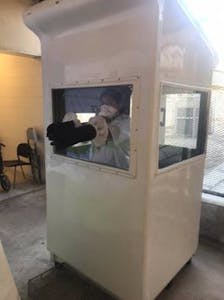In South Africa’s Wesfleur Hospital — a 50-bed public facility in the Western Cape, 25 miles north of Cape Town — staff are refashioning security booths into makeshift COVID-19 testing centers.
Front windows are replaced with plexiglass, and two holes are made in the plastic to fit the arms of health workers performing nasal swabs.
Think of a kiosk — with arms.

“With COVID-19 being relatively unknown, staff were scared to do the swabbing of patients. Even with PPE [personal protective equipment], the fear remained,” said Dr. Earl Meyer, manager of medical services at the hospital. “Now, staff who were initially fearful are the ones conducting the most swabs.”
Previously the country’s COVID-19 epicenter, the Western Cape is now approaching its peak. The area has more than 82,000 positive cases, or around 28% of the caseload in the country, which is home to the highest number of infections on the continent. A large number of these cases are concentrated in largely poor, Black townships, where residents live in crowded conditions with limited access to water and where unreliable internet or television access makes it difficult to receive information about the virus.
At the same time, South Africa has a twin disease — the world’s largest HIV epidemic, with roughly 20% of adults (15-49 years) in the country living with the virus. An estimated 520,000 of those cases are in the Western Cape and also disproportionately affect Black Africans. The World Health Organization (WHO) and UNAIDS have warned that past gains made in the HIV response may be threatened during the COVID-19 pandemic.
A six-month disruption to supplies of antiretroviral medicines, for example, could lead to an additional 500,000 deaths in sub-Saharan Africa in 2020-2021 and could also increase new transmissions from mother to child. Resurgence of HIV in patients when they are off their antiretroviral therapy could cause overall increased transmission of the virus. One early study from the Western Cape indicates that individuals living with HIV have a modest increased risk of dying from COVID-19 compared with HIV-negative patients, with less than 10% of COVID-19 deaths attributable to HIV. Noncommunicable diseases such as hypertension and poorly controlled diabetes posed the greatest risk of acquiring COVID-19.
“Countries and their development partners must do all they can to ensure that people who need HIV treatment continue to access it,” said WHO Director-General Tedros Adhanom Ghebreyesus. “We cannot let the COVID-19 pandemic undo the hard-won gains in the global response to this disease.”
WHO has issued specific guidelines to help governments assist vulnerable populations, including those living with HIV, during the COVID-19 pandemic. One example is encouraging multimonth dispensing, which South Africa announced in May 2020 it would do by automatically extending antiretroviral medicine prescriptions for six- and 12-month periods. In addition to this guidance, WHO continues to supply South Africa with PPE — including gowns, masks and face shields — to help shore up supplies and protect frontline health workers who are treating both COVID-19 and HIV patients.

Amid these challenges, Meyer and the Wesfleur Hospital team are bracing themselves for the peak of the novel coronavirus, which is expected any day now. Through their innovative testing booths, they have been able to screen thousands of people and increased COVID-19 testing in their area by more than 400%.
The idea caught on. After Wesfleur started repurposing their security booths, other facilities in the Cape Town metropolitan area took note and started to procure similarly designed booths from the Department of Health.
“At the time we introduced the modified outdoor booth, we had no in-patients related to COVID-19,” Meyer said. “Things have since changed dramatically. With our testing booth, we’ve established a very effective community testing site.”
SUPPORT WHO’S EFFORTS IN SOUTH AFRICA AND AROUND THE WORLD
As South Africa continues to fight the virus, the World Health Organization is working alongside it to provide guidance and support. Through its international network and presence in 149 country offices, including 47 African countries, WHO remains the hub of lifesaving, data-driven information. The organization also leads efforts to distribute millions of diagnostic kits and pieces of PPE to 2.3 million health workers around the world.
At @WHOAFRO, our biggest asset is our dedicated community. These are the people who make it happen! 💙 pic.twitter.com/vpcvaA6DDM
— WHO African Region (@WHOAFRO) June 6, 2020
CONSIDER A DONATION TODAY
Every donation makes a difference. Support WHO’s lifesaving efforts to respond to the COVID-19 pandemic by giving to the COVID-19 Solidarity Response Fund. Donations made via Facebook will be matched up to $10 million.
Donate to the COVID-19 Solidarity Response Fund
Featured Photo: GCIS



 View All Blog Posts
View All Blog Posts
